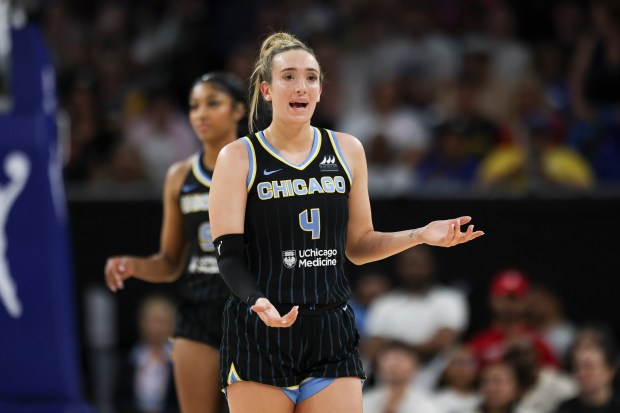The Chicago Sky are the worst 3-point shooting team in the WNBA. They sit last in the league in both attempts (14.5) and makes (4.5) per game and are 11th in percentage (30.7%), ahead of only the Seattle Storm (29.6%).
This isn’t a fluke and didn’t happen by accident. The Sky assembled their roster this season with size in mind, drafting two of the best bigs in the 2024 class — Kamilla Cardoso and Angel Reese — to build their future in the paint.
But as the rest of the league places an emphasis behind the arc, the Sky are falling behind in one of the most profitable shooting categories.
Midway through the season, the Sky know this is a problem. But they also don’t want to change.
“We don’t want to just jack 3s,” coach Teresa Weatherspoon said. “We want to do it the right way.”
It’s not a minor imbalance. The Sky take less than half the attempts of the New York Liberty, who lead the league with 10.2 3-pointers on 29.5 attempts per game — and that margin is growing as the season progresses.
The Sky (9-13) still can win without changing their game. They have partially overcome the disparity, ranking ninth in the 12-team league in both scoring (79.2 points per game) and offensive rating (97.8) as they hold on to seventh place in the standings. And other teams have shown it’s possible to succeed without great long-range shooting; the second-place Connecticut Sun (17-5) take the second-fewest 3-pointers.
But the low volume of 3s limits the Sky’s ability to increase production.
“We get it,” general manager Jeff Pagliocca said. “We understand it’s hard to survive a whole season without those numbers increasing. It’s something we work on every single day.”
Pagliocca said his ideal shot profile for the Sky would include 12 to 15 3-point attempts per game. They have finished below 12 in only three games, taking seven attempts against the Liberty on June 4, 11 against the Atlanta Dream on June 8 and 10 in Thursday night’s 91-76 loss to the Liberty.
No other team averages below 17 3-point attempts, but Pagliocca feels that range is a “safe number” for the Sky to get looks behind the arc without sacrificing other offensive strengths.
“Obviously we’re a team that’s not predicated on coming down and taking 30 3s,” Pagliocca said. “We’re putting pressure on the defense in different ways, making plays at the rim. We have a lot of size. We’re also very conscious of the percentages and where we are in attempts, but we can win in other ways.”
The problem is partially one of personnel. Leading scorer Chennedy Carter averages 0.5 attempts. And sharpshooter Marina Mabrey has been mired in a slump, shooting 33.3% behind the arc — the lowest since her rookie season — though she did hit 4 of 5 on Thursday.
The Sky need Mabrey to produce the bulk of their 3-point shooting. But while she provides 46% of their attempts, her shooting has declined in the middle of the season: 26.7% behind the arc in the previous 10 games before Thursday.
One challenge for Mabrey is fulfilling her role as primary 3-point shooter without letting the pressure seep in.
“I do know that I need to provide that — and I know I haven’t been shooting it well,” she said. “I just try to trust my work. It’s the law of averages. I’m not going to miss for the rest of my life.”
The Sky don’t have many other options.
Reserve guard Dana Evans is the only other player averaging at least one made 3-pointer (1.0). Wings Diamond DeShields and Michaela Onyenwere provide occasional boosts from long range.
When the Sky talk about 3-point shooting, they emphasize the same phrase: finding the right shots. But what is the “right shot” for this offense?
Mabrey outlined three ideal sources of 3-point shot creation: playing inside-out from the bigs in the high-low, creating looks off inside screening against a zone defense and kicking out after offensive rebounds. As the best offensive rebounding team in the league, the last option is one of the most underutilized opportunities for the Sky to produce 3-pointers.
But taking more shots isn’t the only issue. The Sky are struggling to execute even when they find their desired spots — which brings the issue back to personnel.
The Sky drafted shooting guard Brynna Maxwell with 3-point production in mind and suffered a considerable loss of potential attempts when an injury in training camp resulted in the rookie being waived.
They attempted to adjust without replacing that production. But with an open roster spot, adding a 3-point shooter might become necessary to weather the second half of the season.
For now, they must settle for improving in the margins.
Improving a shot in season is a tricky task — players have barely enough time to prepare for games. While shooting form is typically built in the offseason, Pagliocca and Weatherspoon are leaning into their player-development backgrounds to improve 3-point shooting form.
“It’s hard to do a lot of mechanical work, especially during these months, because you’re playing games every other day,” Pagliocca said. “We do have coaches working on mechanical shooting every day with the player.
“So, yes, it is more of an offseason thing, but there are tweaks and changes and adjustments. We have players that are very open to that criticism and making those changes, and the work is being put in every day.”



